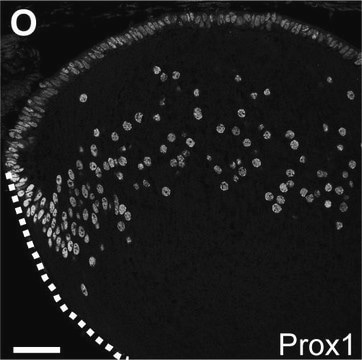MABT1512
Anti-Podoplanin Antibody, clone 8.1.1
clone 8.1.1, from hamster(Syrian)
Sinónimos:
Glycoprotein 38, Gp38, OTS-8, PA2.26 antigen, Transmembrane glycoprotein E11, E11
About This Item
Productos recomendados
biological source
hamster (Syrian)
antibody form
purified immunoglobulin
antibody product type
primary antibodies
clone
8.1.1, monoclonal
species reactivity
mouse
packaging
antibody small pack of 25 μg
technique(s)
flow cytometry: suitable
immunocytochemistry: suitable
immunohistochemistry: suitable (paraffin)
immunoprecipitation (IP): suitable
western blot: suitable
NCBI accession no.
UniProt accession no.
target post-translational modification
unmodified
Gene Information
mouse ... Pdpn(14726)
General description
Specificity
Immunogen
application
Flow Cytometry Analysis: A representative lot detected Podoplanin in Flow Cytometry applications (Farr, A., et. al. (1992). J Histochem Cytochem. 40(5):651-64).
Immunohistochemistry Analysis: A representative lot detected Podoplanin in Immunohistochemistry applications (Farr, A., et. al. (1992). J Histochem Cytochem. 40(5):651-64).
Immunocytochemistry Analysis: A representative lot detected Podoplanin in Immunocytochemstry applications (Kamo, N., et. al. (2006). Am J Physiol Gastrointest Liver Physiol. 292(2):G526-34; Cohen, J.N., et. al. (2010). J Exp Med. 207(4):681-8; Ishii, T., et. al. (2010). Cell Tissue Res. 339(3):505-12).
Western Blotting Analysis: A representative lot detected Podoplanin in Western Blotting applications (Farr, A., et. al. (1992). J Histochem Cytochem. 40(5):651-64).
Immunoprecipitation Analysis: A representative lot immunoprecipitated Podoplanin in Immunoprecipitation applications (Farr, A., et. al. (1992). J Histochem Cytochem. 40(5):651-64).
Cell Structure
Quality
Immunohistochemistry (Paraffin) Analysis: A 1:1,000 dilution of this antibody detected Podoplanin in mouse lung tissue sections.
Target description
Physical form
Storage and Stability
Other Notes
Disclaimer
Not finding the right product?
Try our Herramienta de selección de productos.
Certificados de análisis (COA)
Busque Certificados de análisis (COA) introduciendo el número de lote del producto. Los números de lote se encuentran en la etiqueta del producto después de las palabras «Lot» o «Batch»
¿Ya tiene este producto?
Encuentre la documentación para los productos que ha comprado recientemente en la Biblioteca de documentos.
Nuestro equipo de científicos tiene experiencia en todas las áreas de investigación: Ciencias de la vida, Ciencia de los materiales, Síntesis química, Cromatografía, Analítica y muchas otras.
Póngase en contacto con el Servicio técnico








